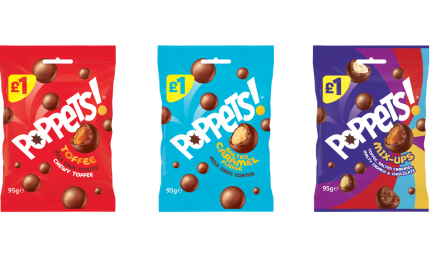As society’s appetite for healthier alternatives continues to grow, the confectionery landscape finds itself at a crossroads, with the emergence of plant-based sweets heralding a new era of indulgence. However, beneath the surface of this seemingly sweet transition lies a complex jungle rife with challenges for both consumers and producers alike. The shift towards plant-based confectionery represents a desire for treats that not only satisfy cravings but also align with incorporating more plant-based products in their lifestyle. Cargill’s bespoke texturizers in gummy research underscores the enduring importance of taste and texture as the primary drivers of consumer choices, emphasizing the need for plant-based sweets to deliver on the promise of delectable experiences.
Evolving tastes in plant-based gummies
Across Europe, there is a palpable enthusiasm for plant-based gummies, reflecting a growing consumer interest in health-oriented products (Source: Texturizers in gummy application sensory and U&A consumer research, January 2024). This surge in demand presents a significant opportunity for producers, albeit accompanied by formidable challenges.
Today’s plant-based consumers won’t accept sweet treats that don’t deliver organoleptically. Sugar confectionery products are inherently indulgent, and must offer the right taste, sweetness, and importantly, texture, in order to succeed. Market success can only be achieved by finding the perfect balance of these aspects.
“Today’s plant-based consumers won’t accept sweet treats that don’t deliver organoleptically”
In the case of gummies, we know that liking is mainly achieved at the intersection of texture and flavor. Yet plant-based texturizers are more difficult to work with in gummies than animal-based ingredients, such as gelatin. So, delivering to these technical and sensory needs requires real formulation know-how when it comes to best applying alternatives, such as pectin, and ingredient blends.
The challenge is further compounded by the fact that there are different opinions on what makes for the right gummy or other sweet treat in the first place. Consumers in different countries have highly divergent perspectives when it comes to key aspects, such as texture. There are also clear differences between someone who prefers premium products, someone who cares about health and sustainability, and those that are purely motivated by cost.
Inside our latest sensory research
To investigate different substitutes for gelatin, we conducted a consumer test in Germany, Spain and the UK, inviting 175 consumers per country to taste five plant-based prototypes and 150 (excl. 25 vegans) a gelatin prototype (Source: Texturizers in gummy application sensory and U&A consumer research, January 2024).
Our results highlighted*:
- Plant-based can compete with gelatine-based solutions: Plant-based solutions have the potential to be scored on par or even better than gelatine-based gummies.
- Texture & flavor dynamics: Irresistible gummies? It’s all about texture and flavor. These factors intertwine, influenced by gender, age, and consumer profiles.
- No one size fits all: Across borders, gummy preferences vary. Gelatin and plant-based options share the spotlight, tied in a flavorful taste-off.
- Plant powered appeal: When consumers learn about a gummy’s plant-based origins, positive perception grows.
- Country trumps vegan unity: Taste buds unite! Vegans and omnivores savor the same flavors in each country.
- Plant-based associates to health according to consumers: Over 60% of UK consumers, 70% of Germans and 85% of Spaniards in Cargill’s research are interested in plant-based gummies and associate plant-based with healthier ingredients.
*Cargill texturizers in gummy consumer research
To meet these regional demands, which ingredient solution works best in plant-based alternative gummies? We know that pectin boasts a very fruity and sweet taste and has great potential in Southern Europe. By contrast, plant-based texturizers in terms of texture properties tend to be closer to gelatin and therefore seem to do better in Northern Europe.
However, to create better performing plant-based gummies that largely match gelatin in terms of texture, some further blending work is required (with texturizers, sweeteners and enrichments) With this, food manufacturers can get even closer to developing the ideal gummy standard.
Cargill’s Food Solutions has the expertise at our disposal to take these types of consumer learnings back to R&D and work with food manufactures to get a more precise blend. By coupling our texture and emulsification solutions with in-depth application and technical expertise, we can help address the most challenging formulation needs.
Behind the scenes – Crafting a range of plant-based gummies
How were we able to test a full range of plant-based texturizers? Different plant-based texturizers bring different properties. Depending on what the consumer desires, there are different roads to create gummies that are successful plant-based alternatives to gelatin textured gummies (on a sugar-based formula). To demonstrate the full range of possibilities we made prototypes incorporating the most frequently used plant-based texturizers (e.g. pectin, starch, and carrageenan) and maximized their properties to clearly differentiate between their properties and sensory profiles.
Label-friendly pectin, sourced from citrus peels or apple pomace is quite stable during shelf-life as its high melting point prevents sticking or melting. For this specific prototype, we preferred to use a high-methoxyl pectin from our UniPECTINE® range which works well for confectionery, providing great texture and flavor release, especially in jellies & gummies.
Carrageenan, however, extracted from red seaweeds, is suitable for less acidic mediums than pectin. Thanks to its nature, a variety of textures can be created, from very soft and elastic to firm and brittle. We chose a special blend which provided an elastic texture that allows for strawberry flavor with good gelation.
Starch might sound like a more complex ingredient from a production perspective, but for us it was easier to deposit the cooked mass formulated with our modified gelling starches, selected from C*Set and C*Clearset range thanks to their lower hot viscosity. The low setting temperatures of these starches gave us the necessary maneuver time to optimize the flavor profile of the gummies.
We also tried to offer some further differentiation by blending some of these ingredients together (done in two options: starch/pectin and starch/carrageenan). There the biggest challenge was finding balance between the different texturizers with divergent dissolving properties. This required some further attention from a production perspective; however, results were really worthy.
The fact that we were able to create six different prototypes (including the gelatin-based reference) using such a broad range of formulations shows how our applications expertise enables us to support our customers with tailor-made solutions.
Solutions for sugar confectionery success
In addition to replicating the desired structure of the prototypes, we also have the tools and physical equipment in-house to produce at both lab and pilot level. For example, in the case of a product made using carrageenan, the holding temperatures are very important and if a customer doesn’t have a proper pilot plant facility and can only do lab scale work, it is difficult to keep it hot. That’s where we can help with our pilot scale capabilities, which ensure we can come as close as possible to replicating manufacturing settings, without having to put a factory production run on pause.
Having sensory involved in the R&D development phase also proves to be highly valuable when it comes to ensuring that the prototypes are distinguishable enough from one another. Furthermore, it allows us to be faster and more proactive to align with customer’s needs during the prototyping phase.
Beyond product offerings, Cargill’s commitment to sensory research and market insights enriches the process of product development, so that plant-based confectionery can may resonate with the diverse tastes and preferences of consumers. By understanding the intricate interplay of texture and flavor dynamics, Cargill empowers producers to help create treats that captivate the senses while aiming to meet the demands of a health-conscious market.
*25 vegan consumers tasted only the plant-based prototypes.
Editorial contact:
Editor: Kiran Grewal kgrewal@kennedys.co.uk







